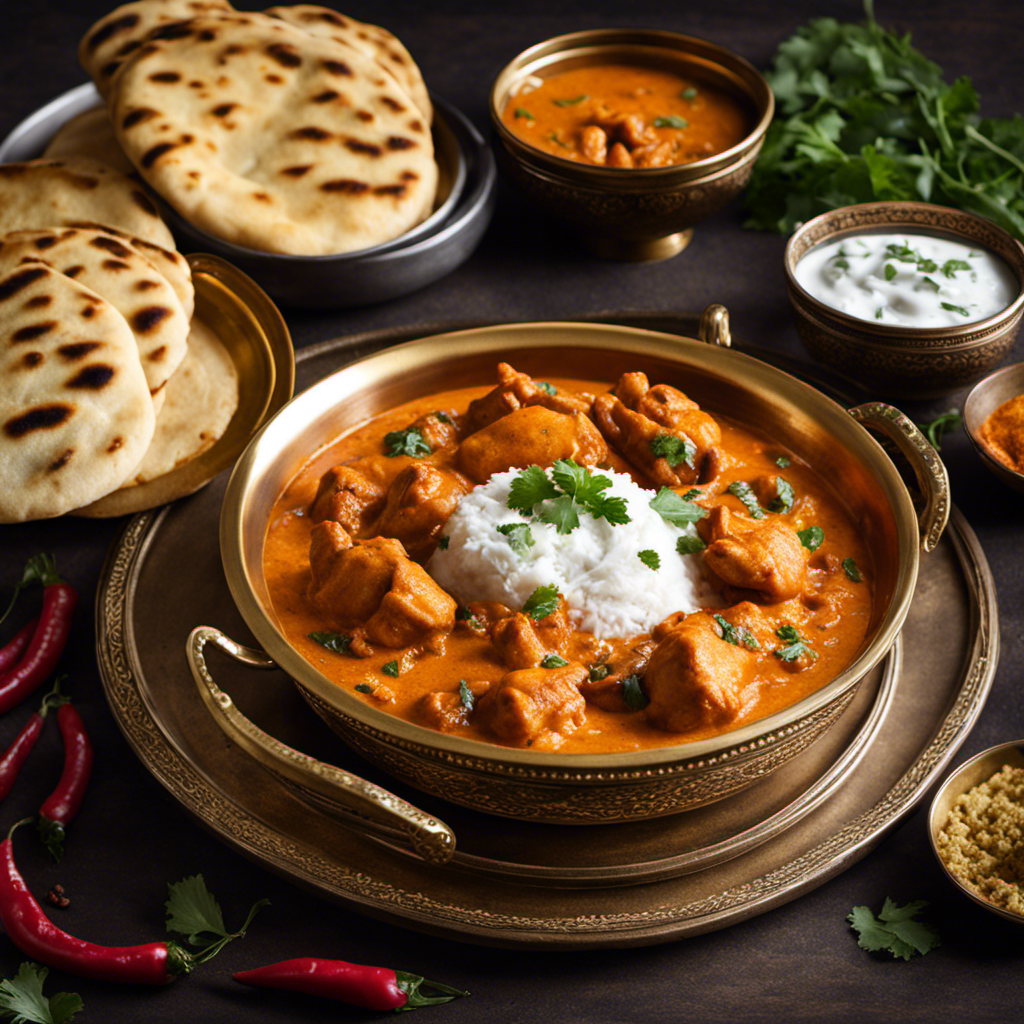Butter can definitely be a valuable part of your balanced diet if you use it wisely and in moderation. It's rich in fat-soluble vitamins like A, D, E, and K, which support your vision, skin, and immune system. A tablespoon provides around 102 calories but can enhance the flavor of many dishes. Pair it with whole grains or veggies for a nutritious boost. Just be mindful of portion sizes to avoid overindulging in saturated fats. Choosing high-quality butter, like grass-fed varieties, can also offer added benefits. There's more to explore about integrating butter into your meals effectively!
Key Takeaways
- Butter can be part of a balanced diet, providing essential fat-soluble vitamins A, D, E, and K.
- Moderation is key; use measured portions to control fat intake while enjoying butter's flavor.
- Grass-fed butter offers additional nutrients, including higher omega-3 fatty acids for better health benefits.
- Pair butter with whole grains and vegetables to create balanced meals that enhance taste and nutrition.
- Mindful consumption of butter supports heart health without compromising overall dietary goals.
Nutritional Profile of Butter
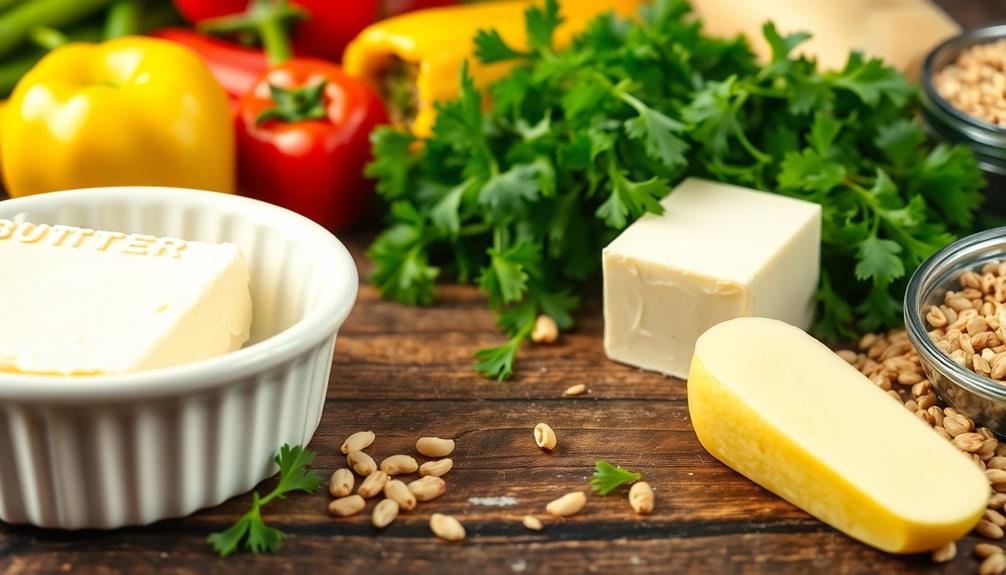
Although butter often gets a bad rap, it actually boasts a rich nutritional profile that can fit into a balanced diet. When you look at butter, you'll find it's primarily composed of fat, specifically saturated fat. This is significant because it provides energy and supports hormone production in your body. One tablespoon of butter contains about 102 calories, which might seem high, but remember, it can enhance the flavor of your meals.
Additionally, butter is a source of vitamins A, D, E, and K, which are vital for various bodily functions. You're also getting fat-soluble vitamins like A, D, E, and K from butter, which play vital roles in various bodily functions. Vitamin A supports vision and immune function, while vitamin D is essential for bone health. Plus, butter contains conjugated linoleic acid (CLA), which some studies suggest may have health benefits.
It's worth noting that the source of butter matters. Grass-fed butter tends to have higher levels of omega-3 fatty acids and vitamins compared to conventional butter, making it a more nutrient-dense choice.
Benefits of Eating Butter
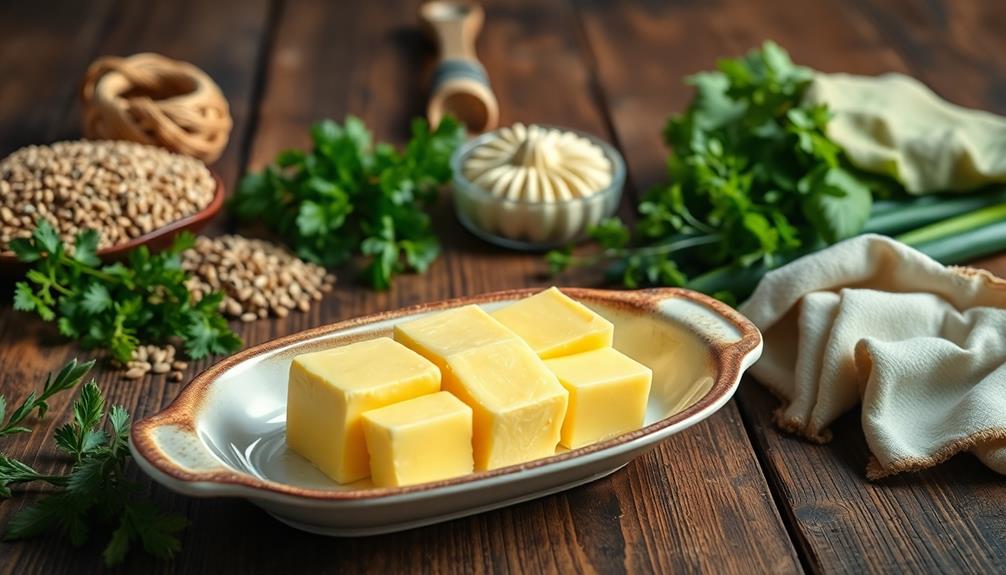
Eating butter in moderation can actually offer several benefits that enhance your overall health. First off, butter is a rich source of fat-soluble vitamins like A, D, E, and K. These vitamins play vital roles in maintaining good vision, supporting the immune system, and promoting healthy skin.
Secondly, butter contains healthy fatty acids, such as conjugated linoleic acid (CLA), which may help in weight management and reducing body fat. It can also support heart health by providing a balance of saturated fats that can increase HDL (good cholesterol) levels.
Here's a quick look at some of the key benefits of eating butter:
| Benefit | Description | Source |
|---|---|---|
| Rich in Vitamins | Supports vision, skin, and immunity | Vitamins A, D, E, K |
| Healthy Fats | Contains CLA and promotes HDL levels | Saturated fats |
| Flavor Enhancer | Adds richness to dishes | Culinary versatility |
| Energy Boost | Provides a quick source of energy | Caloric content |
| Supports Absorption | Enhances nutrient absorption | Fat-soluble nutrients |
Incorporating butter into your diet can definitely provide these benefits when consumed wisely.
Moderation Is Key

When it comes to enjoying butter, moderation truly matters.
You'll want to focus on health benefits while also practicing portion control to keep your fat intake balanced.
Butter can provide essential fatty acids and fat-soluble vitamins its nutritional composition, but being mindful of how much you use is vital.
Health Benefits of Butter
Butter can be a flavorful addition to your diet, offering several health benefits when consumed in moderation. One of the key advantages is that butter is rich in fat-soluble vitamins, particularly vitamins A, D, E, and K. These essential nutrients support various bodily functions, including immune health, bone strength, and skin health.
Historically, butter has been a cherished ingredient in culinary traditions, valued for its versatility and nutrition, as seen in ancient civilizations that recognized its importance in both sustenance and trade its historical significance.
Additionally, butter contains conjugated linoleic acid (CLA), which has been linked to improved metabolism and fat loss. This can be particularly beneficial if you're looking to maintain a healthy weight.
The butyrate found in butter is another significant component; it's a short-chain fatty acid that can promote gut health by supporting the growth of beneficial gut bacteria.
Moreover, butter can be a source of healthy fats, essential for hormone production and nutrient absorption. Including moderate amounts of butter in your meals can enhance the flavor of your dishes while providing these valuable nutrients.
Just remember, it's all about balance—ensure that you're not overindulging and that your overall diet remains diverse and nutritious. Enjoying butter as part of a varied diet can help you reap its benefits without compromising your health.
Portion Control Strategies
Incorporating butter into your diet can enhance flavors and provide health benefits, but managing your portion sizes is essential to reaping these advantages without excess. To enjoy butter while keeping your intake in check, consider these portion control strategies.
First, use measuring spoons or a kitchen scale to determine the right amount. A teaspoon or tablespoon can go a long way in adding flavor without overdoing it. Second, look for ways to combine butter with other ingredients. For example, mixing a small amount of butter with olive oil can create a flavorful dressing. Finally, be mindful of your cooking methods; using butter for sautéing or baking can help distribute its flavor throughout your meal without needing a large quantity.
Here's a quick reference table for butter portion sizes:
| Portion Size | Uses |
|---|---|
| 1 tsp | Spreading on toast |
| 1 tbsp | Cooking vegetables |
| 2 tbsp | Baking recipes |
| ¼ cup | Sauces or dips |
Balancing Fats Intake
A balanced diet includes a variety of fats, and moderation is key to maintaining overall health. You don't have to eliminate butter or other fats completely; instead, focus on the quality and quantity of what you consume. Healthy fats, like those found in avocados, nuts, and olive oil, should make up a significant portion of your fat intake. These fats provide essential fatty acids and can improve heart health.
When it comes to butter, remember that it can be part of a healthy diet if used wisely. Spread it thinly on your toast or use it in cooking, but be mindful of how much you're using. Aim for balance by incorporating a range of fats in your meals. For instance, pair butter with heart-healthy options, like steamed vegetables or whole grains, to create a nutritious dish without overdoing it.
Listening to your body is vital. Pay attention to how different fats affect your energy levels and overall well-being.
Butter vs. Margarine
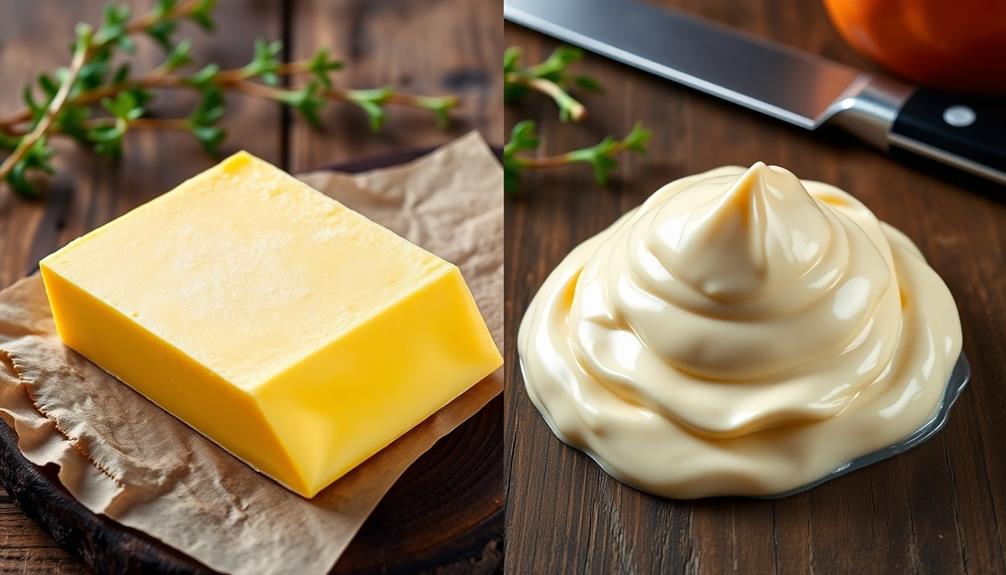
When choosing between butter and margarine, it's important to contemplate their nutritional content and health effects.
You might find that butter offers natural fats while margarine often contains processed oils.
Let's explore how these options stack up against each other in your diet.
Nutritional Content Comparison
Choosing between butter and margarine can be tricky, especially when you're trying to make the healthiest choice for your diet. Both spreadable options have distinct nutritional profiles that can influence your decision.
Butter is a natural product made from cream and contains about 102 calories and 12 grams of fat per tablespoon, with a significant portion being saturated fat. It's also a source of fat-soluble vitamins like A, D, E, and K.
On the other hand, margarine is typically made from vegetable oils and can vary widely in its formulation. While some margarines contain fewer calories—around 50 to 100 calories per tablespoon—their fat content can differ greatly, depending on whether they use healthy unsaturated fats or unhealthy trans fats.
When comparing the two, it's important to reflect that some margarines are fortified with vitamins and may contain no cholesterol.
However, not all margarines are created equal, so reading labels is vital. Ultimately, understanding the nutritional content helps you make an informed decision, ensuring that your choice aligns with your dietary goals and preferences.
Health Effects Analysis
Analyzing the health effects of butter versus margarine can considerably impact your dietary choices.
Butter, made from cream, contains saturated fats, which can raise your LDL cholesterol levels. However, it also offers fat-soluble vitamins like A, D, and E.
On the other hand, margarine, often made from vegetable oils, typically has unsaturated fats, which are better for heart health. Still, many margarines contain trans fats, which are harmful and can increase the risk of heart disease.
When choosing between the two, consider your overall health goals. If you're looking to reduce saturated fat intake or manage cholesterol levels, opting for a soft margarine with no trans fats might be wise.
However, if you prefer a more natural product and enjoy the taste of butter, moderation is key. Using butter sparingly can allow you to enjoy its flavor while minimizing potential health risks.
Ultimately, you should focus on the quality of the fats you consume. Look for margarine options that are free from trans fats and consider incorporating both butter and margarine into a balanced diet, ensuring you enjoy a variety of flavors without compromising your health.
Cooking With Butter

Cooking with butter adds a rich flavor and a delightful texture to a variety of dishes. Whether you're sautéing vegetables, baking pastries, or making sauces, butter enhances the overall taste and mouthfeel of your culinary creations.
Here are four fantastic ways to incorporate butter into your cooking:
- Sautéing: Use butter to sauté vegetables or proteins. Its high-fat content allows for even cooking and a deliciously browned finish.
- Baking: Incorporate butter into your baked goods, like cookies and cakes. It creates a tender crumb and adds moisture, resulting in a delectable treat.
- Sauces: Emulsify butter into sauces for a creamy finish. It can elevate simple sauces to gourmet levels, adding depth and richness.
- Finishing Touch: A pat of butter at the end of cooking can add a luxurious finish to dishes, such as mashed potatoes or risottos, making them extra creamy and flavorful.
Pairing Butter With Foods

The magic of pairing butter with the right foods can elevate your meals to new heights. Whether you're spreading it on your morning toast or using it to finish a rich pasta dish, butter's creamy texture and rich flavor make it a versatile companion.
Here are some excellent food pairings that complement butter beautifully:
| Food Type | Best Butter Pairing | Flavor Profile |
|---|---|---|
| Bread | Garlic Herb Butter | Savory and aromatic |
| Vegetables | Lemon Zest Butter | Bright and invigorating |
| Pasta | Parmesan Butter | Rich and cheesy |
When you incorporate butter into your meals, think about the flavors you want to enhance. For instance, pairing butter with roasted vegetables not only adds depth but also elevates the dish's overall taste. You can also try butter on grilled meats to add a luscious finish. Don't shy away from experimenting with flavors; the right butter pairing can transform a simple dish into something extraordinary. Just remember, moderation is key, and enjoy the delightful experiences that butter brings to your culinary adventures.
Butter in Different Diets

Butter can fit seamlessly into a variety of diets, enhancing both flavor and nutritional value. Whether you follow a low-carb, Mediterranean, or even a vegetarian diet, butter can be a versatile addition. It's all about choosing quality butter and using it mindfully.
Here are four ways butter can complement different dietary preferences:
- Keto Diet: With its high-fat content, butter is perfect for those on a ketogenic diet, helping you stay in ketosis while adding richness to your meals.
- Paleo Diet: On a paleo diet, you can enjoy butter as a natural fat source, especially if you opt for grass-fed varieties, which offer additional nutrients.
- Mediterranean Diet: Incorporate butter in moderation with whole grains and vegetables, enhancing flavors and making your dishes more satisfying.
- Vegetarian/Vegan Alternatives: While traditional butter isn't vegan, you can explore plant-based butters that provide similar mouthfeel and taste, allowing you to enjoy a buttery flavor without compromising your dietary choices.
Integrating butter thoughtfully into your meals can elevate your eating experience while supporting your nutritional goals.
Common Myths About Butter

You might've heard that butter causes heart disease or that all fats are the same, but these are misconceptions that deserve more attention.
Many people also believe butter is always unhealthy, which isn't the case when enjoyed in moderation.
Let's clear up these common myths and explore the truth behind butter's role in your diet.
Butter Causes Heart Disease
Many people believe that consuming butter directly leads to heart disease, but this notion is based on outdated information and common misconceptions.
Recent studies suggest that saturated fats, like those found in butter, don't have the negative impact on heart health that was once thought. Instead, it's important to reflect on the overall quality of your diet and lifestyle.
Here are four key points to keep in mind:
- Nutrient Density: Butter contains important nutrients like vitamins A, D, E, and K. It can be part of a nutritious diet when consumed in moderation.
- Balanced Approach: Instead of fearing butter, focus on a balanced intake of fats. Incorporate a variety of healthy fats from sources like avocados, nuts, and olive oil.
- Whole Diet Matters: Heart disease risk is influenced by your entire diet, including processed foods, sugar intake, and overall caloric balance.
- Lifestyle Factors: Regular exercise, maintaining a healthy weight, and managing stress all play significant roles in heart health, often overshadowing the effects of butter alone.
All Fats Are Equal
When it comes to dietary fats, not all are created equal, and misconceptions about butter often cloud the conversation. You might hear people say that all fats contribute equally to health issues, but that simply isn't true. Butter contains a unique combination of saturated fats, vitamins, and beneficial fatty acids that can play a role in a balanced diet.
Many people lump butter together with unhealthy fats, but this overlooks its nutritional profile. While trans fats and some highly processed oils can be harmful, butter is a whole, natural food that provides essential nutrients. It contains fat-soluble vitamins like A, D, E, and K, which are vital for your body's functions.
Additionally, the type of fat in butter can actually help you absorb these vitamins more effectively. Instead of fearing butter, think about how you can use it mindfully in your meals. It's all about balance. Rather than avoiding butter altogether, consider it as one of many fats you can incorporate into your diet.
Embrace the diversity of fats, and you'll likely find that your approach to cooking and eating becomes more enjoyable and nutritious.
Butter Is Always Unhealthy
The belief that butter is always unhealthy is a common myth that oversimplifies the complexities of dietary fats. In reality, butter can be a part of a balanced diet when consumed in moderation.
Here are some reasons why this myth doesn't hold up:
- Natural Source: Butter is derived from milk and contains essential nutrients like vitamins A, D, E, and K. These vitamins play vital roles in maintaining your health.
- Healthy Fats: Butter contains saturated fats, but not all saturated fats are harmful. Some studies suggest that moderate intake can be beneficial for heart health.
- Flavor Enhancer: Using butter can enhance the taste of your meals, potentially helping you enjoy healthier foods, like vegetables, more.
- Satiation: Adding butter to your diet can increase satiety, which may help you feel fuller and prevent overeating later on.
Tips for Healthy Consumption
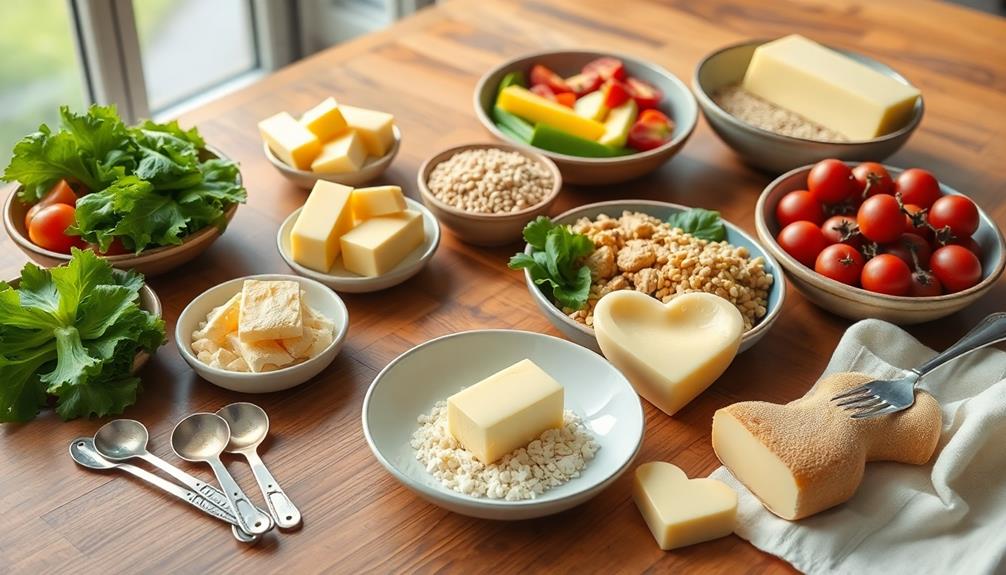
Incorporating butter into your diet can be enjoyable and nutritious if you keep a few key tips in mind. First, opt for high-quality butter, preferably from grass-fed cows. This choice gives you more beneficial nutrients like omega-3 fatty acids and vitamins A and D.
Next, pay attention to portion sizes. While butter can enhance flavor, a little goes a long way. Try using a teaspoon instead of a tablespoon when spreading on bread or mixing into dishes. This way, you can enjoy the taste without overdoing it.
Also, consider balance. Pair butter with whole grains, fruits, or vegetables to create a more rounded meal. For instance, a bit of butter on steamed broccoli can enhance the flavor while providing essential nutrients.
Don't forget to listen to your body. If you notice any discomfort after consuming butter, it's important to assess your intake.
Recipes Featuring Butter

Cooking with butter can elevate your dishes, adding rich flavor and a satisfying texture.
Whether you're baking or sautéing, incorporating butter can transform ordinary recipes into something special.
Here are four delicious recipes featuring butter that you can easily try at home:
- Garlic Butter Shrimp: Sauté shrimp in a generous amount of butter, adding minced garlic and a sprinkle of parsley for a quick and flavorful dish. Serve it over pasta or rice for a complete meal.
- Butter-Basted Steak: Cook your steak in a hot skillet, then add butter, garlic, and herbs. As the butter melts, baste the steak for a mouthwatering crust and juicy interior.
- Buttery Mashed Potatoes: Boil potatoes until tender, then mash them with butter, cream, salt, and pepper. This classic side dish pairs perfectly with any main course.
- Chocolate Chip Cookies: Use softened butter in your cookie dough to achieve that rich, chewy texture. Bake until golden brown for a timeless treat that everyone loves.
Incorporating butter into your cooking not only enhances flavor but also brings comfort to your meals.
Enjoy experimenting with these recipes!
Frequently Asked Questions
Can People With Lactose Intolerance Consume Butter Safely?
If you're lactose intolerant, you might tolerate butter better than other dairy products. It contains less lactose, but it's still wise to start with small amounts and monitor how your body reacts.
How Does Butter Impact Cholesterol Levels in the Body?
Butter can raise your cholesterol levels due to its saturated fat content. If you consume it in moderation, you might manage your cholesterol better. Always balance it with healthier fats for overall heart health.
Is Organic Butter Healthier Than Regular Butter?
You might find organic butter healthier than regular butter due to its lack of synthetic additives and potential higher nutrient content. However, moderation's key, as both types can still contribute saturated fat to your diet.
What Types of Butter Are Best for Baking?
"Baking is an art, not a science." For the best results, use unsalted butter for control over salt levels, or clarified butter for a higher smoke point. Both enhance flavor and texture in your creations.
How Should Butter Be Stored for Optimal Freshness?
To keep your butter fresh, store it in the fridge, tightly wrapped to prevent odors from seeping in. For longer storage, freeze it in portions, ensuring it's well-sealed to maintain flavor and quality.
Conclusion
Incorporating butter into your diet can be a delightful experience, adding rich flavor and creaminess to your meals. While it's important to embrace moderation, don't shy away from this beloved ingredient; it can complement a balanced lifestyle beautifully. By understanding its nutritional benefits and debunking common myths, you can savor butter without guilt. So, as you whip up your next dish, remember that a little indulgence can go a long way in enhancing both taste and satisfaction.





